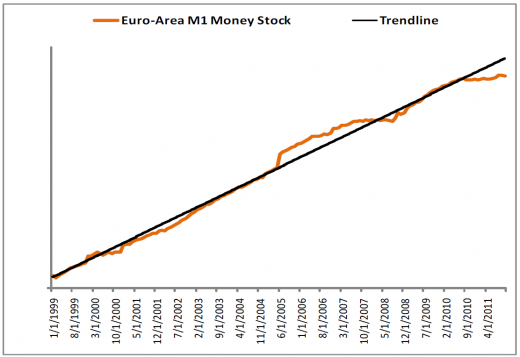This post is not about Austrian economics, a field I know relatively little about. Rather it is a response to dozens of comments I have received by people who claim to represent the Austrian viewpoint. More specifically, it is a response to the claim that the 1929 crash was caused by a preceding inflationary bubble. I will show that the 1920s were not inflationary, and hence that there was no bubble that could have caused an economic slump which began in late 1929.
1. Inflation as price change: Let’s start with the obvious, the 1920s was a decade of deflation; prices fell. Indeed the 1927-29 expansion was the only deflationary expansion of the entire 20th century. That’s right, believe it or not the price level actually declined during the boom at the end of the 1920s.
2. Inflation as money creation: At this point commenters start claiming that inflation doesn’t mean rising prices, it means a rising money supply. I think that is absurd, as that would mean we lack a term for rising prices. But let’s assume it’s true. The next question is; which money? If inflation means more money, then don’t you have to say “base inflation,” or “M2 inflation?” After all, these quantities often go in dramatically different directions. Since the internet Austrians seem to blame the Fed, let’s assume they are talking about the sort of money created by the Fed, the monetary base. In January 1920 the base was $6.909 billion, and in December 1929 it was $6.978 billion. Thus it was basically flat, and this was during a period where the US population and GDP rose dramatically. The broader monetary aggregates rose significantly, but the government didn’t even keep data on M1 and M2 until fairly recently. No one in the 1920s thought the Fed should be targeting aggregates that didn’t even exist.
3. Housing inflation: There was no housing bubble in 1929, so there was nothing to burst and cause a depression.
4. Asset inflation: There was a stock price boom and crash, but we saw a crash of almost identical magnitude in 1987, and it had zero impact on the economy. In any case, it would be odd to call rising stock prices “inflation,” because none of these internet Austrian commenters call falling stock prices “deflation.” Stocks did very poorly during the 1966-82 period, yet I don’t see internet Austrians calling America’s Great Inflation a period of “deflation.”
5. The price of gold: Lots of modern internet Austrians focus on soaring gold prices as an indicator of inflation. If we are going to use gold prices as a proxy, then here are the inflation rates for each year of the 1920s: 0%, 0%, 0%, 0%, 0%, 0%, 0%, 0%, 0%, and 0%.
6. NGDP: Ah, now we are talking. I wish the term ‘inflation’ was used for rising NGDP, not rising prices. And of course Hayek favored a stable NGDP. If that’s what they mean by ‘inflation,’ then they can claim a meager victory for the 1920s, but very meager. NGDP was (according to estimates of Gordon and Balke) $95.98 billion in the first quarter of 1920, and $100.92 billion in the 4th quarter of 1929. That’s an increase of roughly 5% over 10 years, or about 0.5% a year. This means NGDP per capita was falling sharply, as the US population rose by more than 15% during the 1920s. I.e. NGDP per capita did much worse in the 1920s than it has in Japan during an 18 year period where total NGDP actually fell. In fairness, there were sub-periods of faster NGDP growth, such as the 3% annual growth between the 1926:3 and 1929:3 cyclical peaks. But that’s still far below average for the US, and thus I have trouble imagining how it could trigger the severe economic slump in late 1929.
And by the way, interest rates were not particularly low during the 1920s, particularly when you consider that it was a period of deflation. So no one can seriously claim the Fed was following a low interest rate policy.
In my view monetary policy during the 1920s comes closer to the Austrian ideal than any other recent decade. Then in the early 1930s we had deflation by almost any indicator (prices, NGDP, M1, M2, stock prices, etc) and the economy did poorly. Too bad the Fed didn’t try to keep NGDP at $100 billion (as Hayek’s policy rule would have called for), instead of letting it fall to less than $50 billion in early 1933.
Austrian monetary economics has some great ideas–most notably NGDP targeting. I wish internet Austrians would pay more attention to Hayek, and less attention to whomever is telling them that the Depression was triggered by the collapse of an inflationary bubble during the 1920s. There was no inflationary bubble, by any reasonable definition of the word “inflation.”
PS. I hope to do much less blogging in December, as I will be quite busy with various other tasks. Of course if Europe collapses . . .


